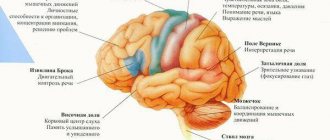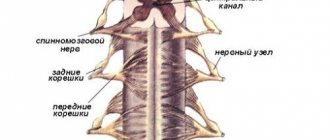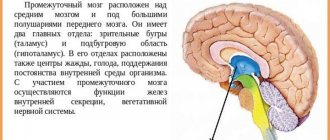Evolutionary development
The modern school biology course covers topics from simple to complex. First we talk about cells, protozoa, bacteria, plants, fungi. Later there is a transition to animals and humans. To some extent, this reflects the hypothetical course of evolution. Looking at the structure of, for example, worms, it is easy to notice that it is much simpler than that of humans or higher animals. But these organisms have something important - a nerve ganglion that performs the functions of the brain.
The nervous system is generally extremely complex. It includes not only the brain and spinal cord, but also numerous processes consisting of special cells, as well as all the sensory organs. Thanks to this system, human life is possible in the form it exists. And, of course, the main organ in it is still the brain, which even in itself has a rather complex structure.
What is all this made of?
As previously mentioned, the human central nervous system consists of the brain and spinal cord. The main structural and functional unit is the neuron. The organization of neurons and their communication with each other is carried out through short and long processes - axons and dendrites. They are responsible for the information exchange in the body required at a particular moment in time. This is ensured by the physiology of neurons - electrochemical processes arising as a result of the exchange of neurotransmitters. An important role in the activity of the nervous system is played by B vitamins, which act as coenzymes.
On average, an adult has a brain mass of 1500 g. Basically, all this mass consists of neurons and their processes, as well as cells that feed this complex complex - neuroglia. It has 3 shells: hard, arachnoid and soft. Human anatomy describes the following brain systems:
- Front.
- Intermediate.
- Average.
- Rear.
Structure and composition
Traditionally, there are five large parts of the brain: the pons, the cerebellum, the medulla oblongata, the midbrain and the cerebral hemispheres. But there is another method of separation. It includes the concepts of brainstem, hindbrain, midbrain and forebrain. The latter is precisely of the greatest interest, since it developed last - in lower vertebrates such division into hemispheres is not observed.
The composition of the brain is quite simple. More than half of its substance consists of water. The rest is lipids, minerals and proteins. It’s even strange what a trivial chemical composition such a complex organ as the brain has.
What forms the forebrain and what functions does it perform?
The forebrain is the most rostral part of the nervous system. It consists of the cerebral hemispheres (cortex) and basal ganglia. The latter, located in the cortex, are located between the frontal parts of the brain and the diencephalon. These nuclear structures include the caudate nucleus and putamen, which together make up the striatum. It got its name due to the alternation of gray matter, consisting of nerve cells, and white matter. These elements of the brain, together with the globus pallidus, which is called the pallidum, form the striopallidal system. This system in mammals, including humans, is the main nuclear apparatus and is involved in the processes of motor behavior and other important functions.
The basal ganglia include subcortical nuclei, which have a very diverse cellular composition. The globus pallidus contains large and small neurons. The striatum has a similar cellular organization. The neurons of the striopallidal system receive impulses from the cerebral cortex, thalamus, and brainstem nuclei.
What functions do the subcortical nuclei perform?
The nuclei of the striopallidal system are involved in the coordination of movements and motor activity. Irritation of the caudate nucleus causes stereotypical head turns and trembling movements of the arms or forelimbs in animals. In the process of studying the striatum, it was found that it is important in the processes of memorizing movements. An irritating effect on this structure disrupts the processes of memory and learning. The striopallidal system has an inhibitory effect on motor activity and its emotional components, for example, on aggressive reactions.
Cerebral cortex
The forebrain includes a structure called the cortex. It is considered the youngest formation of the brain. Morphologically, the cortex consists of gray matter that covers the entire brain and has a large area due to numerous folds and convolutions. Gray matter consists of a huge number of nerve cells. Due to this, the number of synoptic connections is very large, which ensures the processes of storing and processing the received information. Based on the appearance and evolution, ancient, old and new bark are distinguished. During the evolution of mammals, the neocortex developed especially rapidly. The ancient cortex contains olfactory bulbs and tracts, olfactory tubercles. The old one includes the cingulate gyrus, amygdala and hippocampal gyrus. The remaining areas belong to the neocortex.
The nerve cells of the cerebral cortex are arranged in layers and in an orderly manner, forming six layers in their composition:
1st - called molecular, formed by a plexus of nerve fibers and contains a minimal number of nerve cells.
2nd - called external granular. It consists of small neurons of different shapes, similar to grains.
3rd - consists of pyramidal neurons.
4th - internal granular, like the outer layer, consists of small neurons.
5th - contains Betz cells (giant pyramidal cells). The processes of these cells (axons) form a pyramidal tract, which reaches the caudal areas and passes into the anterior roots of the spinal cord.
6th - multiform, consists of triangular and spindle-shaped neurons.
Although the neural organization of the cortex has much in common, a more detailed study of it showed differences that appear in the course of the fibers, the size and number of cells and the branching of their detritus. By studying the human brain, a map of the cortex was compiled, which includes 11 regions and 52 fields.
What is the forebrain responsible for??
Very often, ancient and old bark are combined. They form the olfactory brain. The forebrain is also responsible for alertness and attention, and is involved in autonomic reactions. The system takes part in instinctive behavior and the formation of emotions. In animal experiments, when the old cortex is irritated, effects associated with the digestive system appear: chewing, swallowing, peristalsis. Also, an irritating effect on the tonsils causes a change in the function of internal organs (kidneys, uterus, bladder). Some areas of the cortex are involved in memory processes.
Together, the hypothalamus, limbic region and forebrain (ancient and old cortex) form the limbic system, which maintains homeostasis and ensures the preservation of the species.
Forebrain
If you ask someone to draw the contents of a human skull, they will most likely draw a diagram of the hemispheres. This is truly one of the most noticeable and largest parts. But the forebrain also contains the medulla oblongata. In general, their structure is quite complex. And if we take into account a more detailed division, then we can even name all the parts of the forebrain:
- limbic system;
- hippocampus;
- basal ganglia;
- big brain.
Of course, there is an even more detailed division, but, as a rule, it is of interest only to specialists. Well, for those who are simply expanding their horizons, it will be much more interesting to find out what all these departments are doing. So what are the functions of the forebrain? And why are there differences between the thinking of right-handers and left-handers?
Functions
The forebrain includes the most recently developed parts. And this means that it is thanks to them that a person has the qualities that he has. And if the diencephalon is mainly concerned with the regulation of metabolism, primitive reflexes and needs, as well as simple motor activity, then the hemispheres are the very place where conscious thoughts arise, where learning and memorization of information occurs, and something new is created.
The hemispheres are also conventionally divided into several parts-zones: parietal, frontal, posterior and temporal. And here there are cells that are involved, among other things, in the analysis of information coming from outside: visual, auditory, olfactory, gustatory and tactile centers.
The most interesting thing is that from a functional point of view, the left and right hemispheres are different. Of course, there are cases when, when one part of the brain was damaged, another took over its tasks, that is, there is a certain interchangeability, but in a normal case the situation could be like this: the left hemisphere is engaged in analyzing the intonation of another person’s speech, and the right hemisphere is engaged in interpreting the meaning of what was said. This is why left-handers and right-handers, who have more developed different parts, think slightly differently.
Also, the functions of the forebrain include memory, various reactions to external stimuli, planning and constructing future scenarios and situations. The speech center is also located here. All higher nervous activity takes place here: creativity, reflection, ideas.
It is also quite interesting that the forebrain actively develops not only in the prenatal period, but also in the first few years of life. Every new skill and skill, a learned word, any important information - all this forms new neural connections. And this kind of map is unique for each person.
Components and its functions
Hemispheres of the brain. Some of the important components that are separated by the posteroanterior cavity. The parts are connected by the corpus callosum - this is a white wall. The upper ball itself is covered with a shell of neurons and gray matter, arranged in columns in several layers. The surface of the hemispheres has the form of folds, convolutions and depressions, which are called grooves. It is these depressions that divide the brain into the temporal, frontal, parietal and occipital parts. They are named after the bones they are adjacent to. In neurons, the analysis of nerve connections that come from outside is carried out, these are visual, auditory, and neurons responsible for muscle activity. Gustatory and olfactory neurons are located in the temporal lobe, while behavioral neurons are located in the anterior gray matter. The central zone is responsible for human activity.
The main feature of the hemispheres is that they differ significantly from each other. For right-handed people, the neurons responsible for speech are located in the left hemisphere, and the right hemisphere is responsible for actions, logical chains, recognition of faces, songs, paintings and other things. Under the influence of external stimuli, experience is created and accumulated. In the hemispheres, to summarize and say briefly, the main centers are formed that interact with the most complex patterns of behavior, instincts and memory.
The diencephalon consists of three parts: lower, upper and central. Everyone has heard the word thalamus at least once - this is precisely the upper part of the diencephalon. It, in turn, is made up of the ventricle and paired formations. This is where all information from outside comes in, the initial assessment takes place and then passes further into the cortex of the human intellect. The hypothalamus is the lower part, which performs the function of metabolism and regulates brain energy. In the centers of the hypothalamus there are nuclei that are responsible for various sensations. In combination with the components of gray matter in impulses supplied for motor activity.
Useful to know: Convolutions and grooves located in the brain: structure, functions and description
to contents ^
Interesting Facts
- Thinking abilities do not depend on the mass of the brain, but correlate with such a value as the number of convolutions.
- The speed of signals between neurons reaches 288 kilometers per hour. As you get older, this figure decreases.
- The brain consumes the largest amount of energy among human organs - about 20%. This is a huge indicator, considering that its mass in relation to the body is only 2%. Also, for its normal operation, a sufficient amount of fluid in the body is necessary.
- The statement that the brain uses only 10% of its resources is a myth. Indeed, not many centers can work at the same time, but one way or another they are all involved.
hindbrain
The pons and cerebellum should be classified as the hindbrain. Some specialists include the brain stem, one of its most important areas, in this same department. The fact is that the trunk contains centers that regulate all vital processes - heartbeat, breathing. If the brain stem is damaged, death can occur instantly.
The pons contains the nuclei of the cranial nerves and the reticular pharmacy. Due to the peculiarities of its structure and connection with the medulla oblongata, all paths from the spinal cord to the forebrain, to the cerebellum and brainstem structures pass through this lobe. Lesion in any area can lead to paralysis, loss of sensation and other neurological complications.
The cerebellum consists of two hemispheres and the vermis. The hemispheres are covered with a bark in which there are deep grooves. Due to the specificity and function of the cerebellum, it is connected with the vestibular system, spinal cord, and cerebral cortex, because The main function of the cerebellum is the ability to walk upright and balance.







